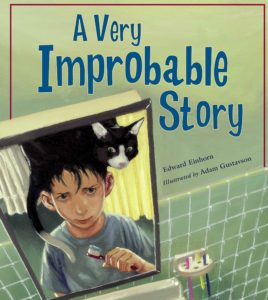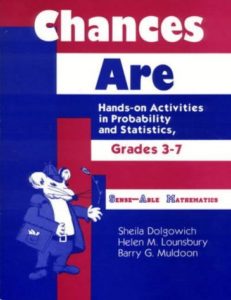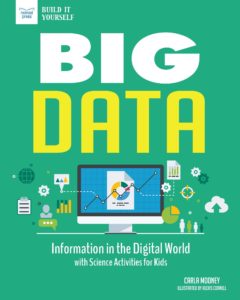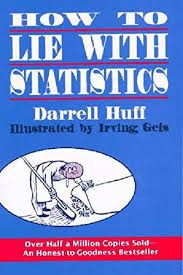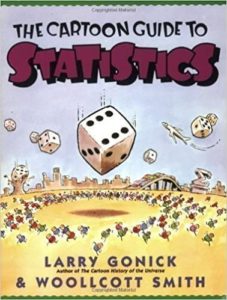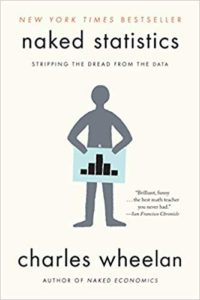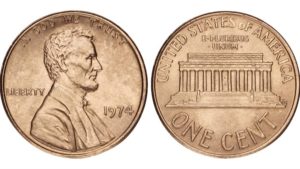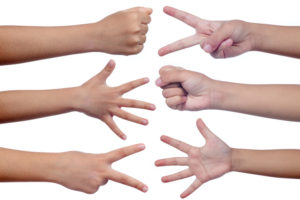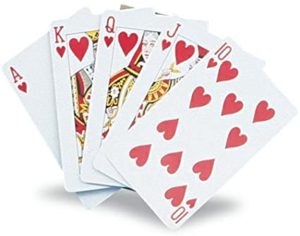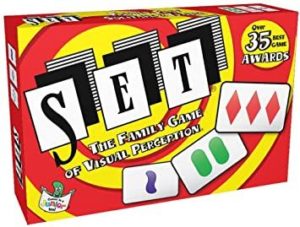 |
Set, “the family game of visual perception,” is a diabolically clever exercise in mathematical thinking. It’s a (deceptively) simple card game, consisting of 81 cards, each printed with one of three basic shapes: a diamond, a lozenge, or a fat squiggle. On each card, the shapes appear in different numbers, colors, and shadings. To play, the dealer lays out 12 cards, face up, and all players attempt to identify three cards that make a set: that is, three cards in which each feature (shape, number, color, shading) is either exactly the same or completely different. When you’ve managed to do so, you yell “Set!” and remove those three cards from the board; the dealer then adds three new cards and the set-search begins again. Everybody plays at once, which means that nobody has a chance to get bored, and the game is considerably more challenging than it first appears. It is appropriate for persons aged 5 through adult, and adults – believe me – have no advantages over younger players. |
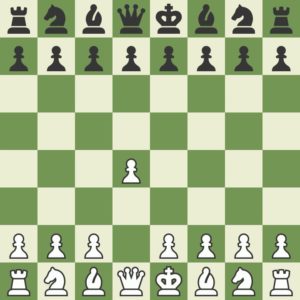 |
Chess might be the ideal teaching tool. It’s all about strategy and patterns, lines and angles, spatial analyses, weighing options and making decisions. Research shows it boosts academic achievement, but it’s also challenging and fun. Also Harry Potter played it. |
|
Doubtless one reason that it’s so successful is that it’s self-empowering – players figure a lot of it out on their own – and it provides a range of intellectual benefits without overtly trying to do so. Recommended age for introducing chess to kids is around 8 or 9, but there are no hard and fast rules. |
|
ChessKid has a tutorial on playing chess targeted at kids; young players can also sign up (safely) to play with others online. |
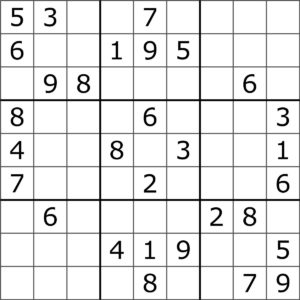 |
Sudoku puzzles are applied logic puzzles, played on a 9×9 grid, with nothing more than a pencil (eraser also highly recommended) and brains. The puzzle grid is subdivided into nine 3×3 blocks or regions; the trick is to enter the numbers 1 through nine (with no repetition) in each horizontal row, vertical column, and block. (“Sudoku” or “su doku” means “numbers singly” in Japanese.) In each puzzle, a few number clues are present on the grid – these cannot be changed and players must work with and around them while solving the puzzle. Sudoku puzzles range in difficulty from the easy to the fiendish; and all are excellent and mind-expanding exercises in the art of logical thinking. (This isn’t arithmetic. It’s more like chess.) |
|
There are many books of sudoku available, including some specifically for children – see, for example, Alastair Chisholm’s The Kids’ Book of Sudoku 1 (Simon & Schuster, 2005). |
|
Web Sudoku offers zillions of puzzles – variously classified as easy, medium, hard, and evil – that can be printed or played online. Also see Gamehouse Sudoku, which has online puzzles at five levels of difficulty. |
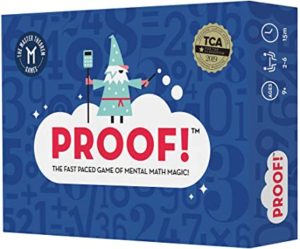 |
In Proof, an award-winning game of mental math for 2-6 players ages 9 and up, kids race to identify equations in a grid of number cards. Fast, fun, and easy – it’s like Set, but with numbers. |
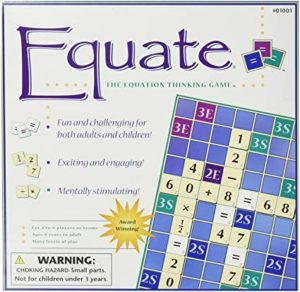 |
Equate (Conceptual Math Media) is a board game for ages 8 and up. Basically, it’s Scrabble with addition, subtraction, multiplication, and division instead of spelling. |
|
Coolmath4Kids, in bright flashy colors, has dozens of categorized math games, geometry/art projects, printable flash cards, dozens of online calculators, cool apps, and more. |
|
Math Playground has dozens of online math games, variously involving numbers, logic, math manipulatives, and word problems, along with interactive projects, worksheets and flashcards, and more. Click on “Common Core Math” to find grade-by-grade games and challenges aligned to the Common Core. |
|
PBSKids’ selection of Math Games includes dozens, among them Juggling George, Send in the Trolls, Star Swiper, Vegetable Planting, the Great Shape Race, and many more. Experiment. |
|
Calculation Nation has math-based games for upper elementary- and middle-school-level students, in which kids can challenge themselves or play against others. |
